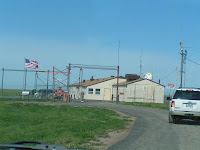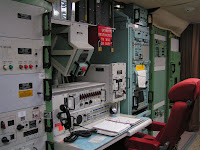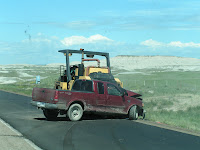
A few short miles from the northeast entrance to the Badlands is the Minuteman Missile National Historic Site Visitor Contact Station which offers free tours of an underground launch control center and a missile silo. When we initially planned our trip to the Badlands, we definitely wanted to include a tour of this facility. Reservations are required for one of the two tours given daily and cannot be made more than 60 days out. We marked the calendar and exactly 60 days prior to the date we wanted, we called to make a reservation for the 9am tour. Designated a National Historic Site in 1999 to illustrate the history and significance of the Cold War and the arms race, it is run by the National Park Service (
http://www.nps.gov/mimi/), and tours were begun in 2004.

The tour starts at the Contact Station from where everyone departs in their own vehicles following the ranger to the first stop 4 miles down the highway to the Delta-01 Launch Control Center. Here the group of 18 visitors was divided into 3 groups, and each went with one of the rangers. The Control Center looks like a typical ranch house

from the outside surrounded by a chain link fence. Our portion of the tour started outside with Alex, who gave an overview of the facility and minuteman missile program during the Cold War, while the others began their tour inside. Contrary to what you might think, the missiles and their locations were not “top secret”. The public knew about them and where they were as did the Soviets; they were “hidden in plain sight”.

From here we proceeded inside to tour the living quarters, dining area, day room, kitchen, and security control center where the Air Force support personnel lived and worked, with each crew working 3-days on and 3-days off. There were always a minimum of 8 people occupying the topside including a facility manager, cook, and 6 security police.

Except for the facility manager who had his own room that doubled as his office, the men were housed 4 to a room and at the end of each shift their gun was to be cleaned and emptied. To confirm this had been done, in each bedroom was a round red canister with a square hole. Each man would place his gun into the canister and fire. If the firing made a sound (meaning it was not empty), the officer would be severely reprimanded and could even lose a stripe.

From here our group advanced to the elevator which took us 31 feet beneath the surface to see the actual underground Launch Control Center. This is where the Air Force missileers worked 24 hour shifts, two at a time. The reason we were initially divided into such small groups becomes evident very quickly. The elevator is an extremely tight squeeze for the 7 us as it was meant for no more than 3 or 4 people. As you step off, the first thing you see is the 8 ton blast door on which some industrious personnel had painted a take-off of a Domino’s ad on the outside. The Control Center is a separate egg-shaped container that was fully self-sufficient should the unthinkable happen. (See photo below right of the container

as it was placed in the ground.)


A commander and a deputy, each working at separate consoles in tight quarters, were in charge of controlling 10 Minuteman Missiles in the event of a first strike by the Soviet Union. Contrary to popular myths and movies, there is no “red button” that is pressed to launch. When the executive order came to launch, they went through a series of procedures to authenticate and verify the message. Following these procedures the missileers would remove separate locks off a red box that held a set of keys. Each missileer took one key and inserted their key in the appropriate slot at their console. At another Launch Con

trol
Center the same procedure was being followed. In other words, for security purposes 4 missileers were required to perform a launch. After all keys were inserted, a countdown began and at the end the missileers turned their keys simultaneously. The commander’s console had a series of lighted panels for each missile and was able to track when all missiles had been launched and the mission completed.

Now it was time for everyone to assemble again topside to head for the silo, Launch Facility Delta-09. Only one ranger is required for this part of the tour, so we followed him 11 miles further up the highway, and we were fortunate that this volunteer ranger was Allan Martens. Allan was actually a Launch Control Offi

cer in 1962 so had lots of firsthand knowledge. We only wish we had been in his group at the Control Center. Aboveground at the silo are several antennas, security sensors, and an armored car. Allan explained how the missile would launch, the power of its warhead, and what happened to all the silos at the end of the Cold War. The glassed enclosure you see in the photo houses a Minuteman II missile (the tall missile looking thing next to it is actually an antenna). Looking down t

hrough this glass enclosure you see the actual missile which is housed in a circular, reinforced concrete silo (the warhead has been removed). The entire tour lasted less than 2 hours and was fascinating. Definitely would recommend for anyone visiting the Badlands area.

From the moment we entered the state of South Dakota, we continually passed billboards and very clever signs along I-90 inviting a visit to Wall Drug Store and that it wasn’t to be missed. Located only another 6 miles up the highway from the

missile silo, we figured we had to check it out. Wall Drug (
http://www.walldrug.com/) is definitely a tourist attraction with something for everyone. It’s almost like a 76,000 square foot cowboy themed shopping mall consisting of a drug store, gift shop, restaurant, art gallery, and so much more, ev

en a chapel. You can buy aspirin or spend a couple thousand dollars on a piece of art!
Purchased in 1931 by Dorothy and Ted Hustead, business was not very good for the little drug store and about 5 years later Dorothy came up with the idea to advertise free ice water to weary travelers. The gimmick worked and the rest is history. That history of how

all this came about is shared in Ted’s own words under the History tab on the website listed above…a good and amusing read.
Over the years the business has continued to expand and in 1995 added the “Back Yard”. There are all sorts of photo taking props, i.e. a 6 foot tall jackalope, a Mt. Rushmore replica, even

a bucking bronco (which Russ couldn’t resist). Here you will also find a life-sized T-Rex that moves and roars every 12 minutes. It is located behind an “electric fence” and stands guard at the end of a long hallway.


Not only are there hundreds of signs along I-90 in South Dakota, they can even be found in neighboring states. In addition, many visitors of Wall Drug have erected signs throughout the world announcing the miles to Wall Drug from where they are. For instance, expedition member at the South Pole declared that Wall Drug was 9,333 miles distant.

Guess we’re not good typical tourists since the only thing we bought was lunch, but a good lunch it was with nice sized sandwiches. As we were leaving, we passed the town library and what is evidently their method for the townspeople to pay their utilities. Now that’s a small town!
The Hustead family still owns and operates Wall Drug, and they still offer free ice water plus 5 cent coffee. Stop by, take a load off, and cool off if you’re ever in the area.
That night we finally made it to the Night Sky Program at the Badlands Amphitheater. The first night we were too tired to go and the next two nights it rained. It doesn’t start till 9pm and though there was a possibility of more rain, we decided to head over. An astronomy-trained park ranger did a PowerPoint presentation about the night sky, and it was to follow with laser lead tour of the constellations followed by the use of their large state-of-the-art telescope and binoculars to see the moon, planets, galaxies, etc. The ranger made the presentation fun and interesting but unfortunately the clouds rolled in by the end of it and he canceled the rest of program. Oh, well, guess we’ll have to look at them on our own.
From the Badlands it was time to head for Rapid City, SD, and Mount Rushmore. We decided to take the back road, heading west on Hwy. 44. Part of it was under construction, and at one point we had a slight wait for the oncoming traffic. It was now our turn and we were 2nd in line behind the pilot car and another RV with a line of cars behind us. We came upon a section where the right lane was paved but the pilot car continued on to the dirt road on the left. Obviously we weren’t supposed to drive on the paved section yet, but they didn’t have any barricades up either. Suddenly

a maroon pickup with 3 guys came racing past us on the right, and we figured the guys were part of the road crew. A couple minutes later we saw that same pickup crashed sideways into one of those huge pavement roller machines. Our guess is that he saw the road construction too late, slammed on his brakes, and the truck spun slamming into the road roller. Our traffic line was stopped momentarily as members of the road crew ran to the accident. The two passengers got out looking rather dazed, but as we passed I could see that the driver was pinned in, his chest against the steering wheel. I think he was still alive but don’t know for sure. About 10 min. later a sheriff passed us, siren blaring, and we knew where he was headed. Another 20 min. later the ambulance passed us coming from Rapid City and heading in that direction. It was a rather sobering scene, and all we could do was pray that the young man was okay.

No comments:
Post a Comment